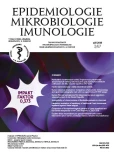Detekce rotaviru A u lidí – srovnání enzymatické imunoanalýzy a rychlého imunochromatografického testu se dvěma metodami kvantitativní RT-PCR
Authors:
R. Moutelíková 1; M. Dvořáková Heroldová 2; V. Holá 2; P. Sauer 3; J. Prodělalová 1
Authors‘ workplace:
Veterinary Research Institute, Brno, Czech Republic
1; Department of Microbiology, Faculty of Medicine, Masaryk University Brno and St. Anne's Faculty Hospital, Brno, Czech Republic
2; Department of Microbiology, Faculty of Medicine and Dentistry, Palacký University and University Hospital, Olomouc, Czech Republic
3
Published in:
Epidemiol. Mikrobiol. Imunol. 67, 2018, č. 3, s. 110-113
Category:
Original Papers
Overview
Cíl práce:
Cílem tohoto sdělení je prezentovat výsledky dvou komerčně dostupných souprav určených pro rutinní detekci rotaviru A v lidské stolici ve srovnání s komerčně dostupným kvantifikačním reverzně transkripčním PCR (RT-qPCR) testem a vlastním RT-qPCR testem.
Materiál a metody:
Celkem bylo vyšetřeno všemi čtyřmi metodami 749 vzorků stolice získaných ze čtyř diagnostických laboratoří v průběhu období od března 2016 do června 2017. U jedné třetiny vyšetřených pacientů byla uvedena diagnóza související s postižením gastrointestinálního traktu, zbytek vyšetřených vzorků byl odebrán od pacientů s jinými základními diagnózami. Vzorky byly vyšetřeny metodou enzymatické imunoanalýzy (EIA) (RIDASCREEN® Rotavirus) a rychlým imunochromatografickým testem (RDT) (IMMUNOQUICK® No-Rot-Adeno). Jako referenční metoda byl použit RT-qPCR test (Primerdesign™ Genesig® Kit), který byl také srovnán s vlastním RT-qPCR testem připraveným v naší laboratoři. U referenčního RT-qPCR testu byly vzorky s pozitivním signálem reakce v 28. a vyšším cyklu (Ct ≥ 28) hodnoceny jako negativní, aby byly do srovnání citlivosti metod zahrnuty pouze vzorky klinicky relevantní.
Výsledky:
U obou rutinních diagnostických testů byla stanovena citlivost (EIA – 84,2 %, RDT – 82,5 %) a také specificita (EIA – 97,8 %, RDT – 96,4 %). Prediktivní hodnota pozitivního testu byla 87,3 % pro EIA a 80,3 % pro RDT. Prediktivní hodnota negativního testu byla vypočítána jako 97,2 % pro EIA a 96,8 % pro RDT. Počet pozitivních vzorků zjištěných referenčním RT--qPCR testem s vlastní stanovenou hladinou cut-off byl 15,2 % (n = 114). Srovnání vlastního RT-qPCR testu a referenčního RT--qPCR testu ukázalo velmi dobrou shodu výsledků – citlivost vlastního testu byla 100 % a specificita 99,7 %.
Závěry:
Metoda RT-qPCR je pro sledování výskytu rotavirové gastroenteritidy citlivější metodou než rutinně používané testy EIA a RDT. Tyto dva testy ve srovnání s referenční metodou vykázaly velmi dobrou specificitu. Test EIA byl však ve všech sledovaných parametrech funkčnosti vyhodnocen lépe než RDT.
KLÍČOVÁ SLOVA
rotavirus A – enzymatická imunoanalýza – imunochromato-grafický test – RT-qPCR
Sources
1. Clark A, Black R, Tate J, et al. Estimating global, regional and national rotavirus deaths in children aged <5 years: Current approaches, new analyses and proposed improvements. PLoS One, 2017;12(9):e0183392.
2. Rheingans RD, Antil L, Dreibelbis R, et al. Economic costs of rotavirus gastroenteritis and cost-effectiveness of vaccination in developing countries. J Infect Dis, 2009;200:S16–S27.
3. Patel MM, Steele D, Gentsch JR, et al. Real-world impact of rotavirus vaccination. Pediatr Infect Dis J, 2011;30:S1–S5.
4. Pazdiora P, Beneš Č. Rotavirus gastroenteritis in the Czech Republic before the start of vaccination. Epidemiol Mikrobiol Imunol, 2013;4:131–137.
5. Graham DY, Dufour GR, Estes MK. Minimal infective dose of rotavirus. Arch Virol, 1987;92:261–271.
6. Anderson EJ, Shippee DB, Tate JE, et al. Clinical characteristics and genotypes of rotavirus in adults. J Infect, 2015;70(6):683–687.
7. Vybrané infekční nemoci v ČR v letech 2007–2016 – relativně [online]. [cit. 2018-02-12]. Dostupné na http://www.szu.cz/publikace/data/vybrane-infekcni-nemoci-v-cr-v-letech-2007-2016-relativne>
8. Bishop RF, Davidson GP, Holmes IH, Ruck BJ. Detection of a new virus by electron microscopy of faecal extracts from children with acute gastroenteritis. Lancet, 1974;1:149–151.
9. Desselberger U. Rotaviruses. Virus Res, 2014;190:75–96.
10. Fischer TK, Gentsch JR. Rotavirus typing methods and algorithms. Rev Med Virol, 2004;14:71–82.
11. Pang XL, Lee B, Boroumand N, et al. Increased detection of rotavirus using a real time reverse transcription-polymerase chain reaction (RT-PCR) assay in stool specimens from children with diarrhea. J Med Virol, 2004;72:496–501.
12. Malenovska, H. Virus quantitation by transmission electron microscopy, TCID50, and the role of timing virus harvesting: A case study of three animal viruses. J Virol Methods, 2013;191:136–140.
13. Lagare A, Moumouni A, Kaplon J, et al. Diagnostic accuracy of VIKIA® Rota-Adeno and Premier™ Rotaclone® tests for the detection of rotavirus in Niger. BMC Res Notes, 2017;10:505.
14. Phillips G, Lopman B, Tam CC, et al. Diagnosing rotavirus A associated IID: Using ELISA to identify a cut-off for real time RT-PCR. J Clin Virol, 2009;44:242–245.
15. Wang H, Liu M, Sugata H, et al. Development of a new enzyme immunoassay for improved detection of rotavirus in fecal specimens of vaccinated infants. J Clin Virol, 2018;99–100:44–49.
16. Matthijnssens J, Ciarlet M, Rahman M, et al. Recommendations for the classification of group A rotaviruses using all 11 genomic RNA segments. Arch Virol, 2008;153:1621–1629.
17. Kim J, Kim HS, Kim H-S, et al. Evaluation of an immunochromatographic assay for the rapid and simultaneous detection of rotavirus and adenovirus in stool samples. Ann Lab Med, 2014;34:216–222.
18. Jeong S, Than VT, Lim I, Kim W. Whole-genome analysis of a rare human Korean G3P[9] rotavirus strain suggests a complex evolutionary origin potentially involving reassortment events between feline and bovine rotaviruses. PLoS One, 2014; 9(5):e97127.
Labels
Hygiene and epidemiology Medical virology Clinical microbiologyArticle was published in
Epidemiology, Microbiology, Immunology

2018 Issue 3
Most read in this issue
- Srovnání epidemiologických charakteristik výskytu lymské boreliózy a klíšťové encefalitidy v České republice v letech 2007–2016
- Fekální bakterioterapie v léčbě klostridiové kolitidy
- Úspěšná léčba rituximabem pro granulomatózně-lymfocytární intersticiální plicní nemoc provázející běžnou variabilní imunodeficienci
- Citlivost klinických izolátů Bordetella pertussis na chemické látky
